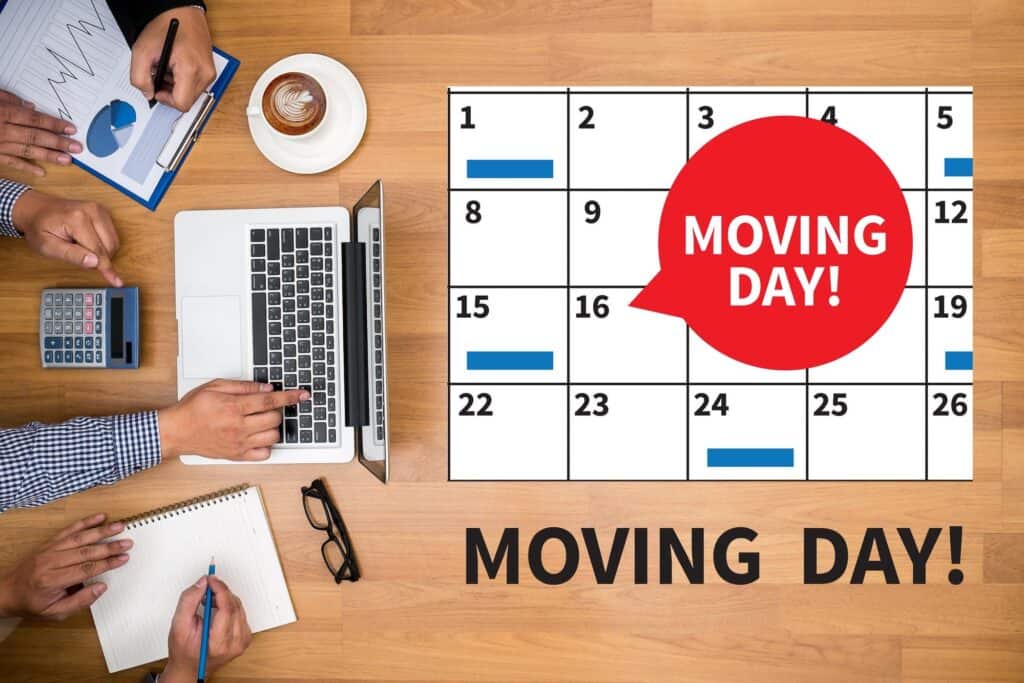Facing an office move and not sure where to start? Our comprehensive guide on how to plan and coordinate an office move will help. We provide clear steps and practical tips to manage timelines, set budgets, inform your team, and handle logistics. Make your transition seamless and stress-free.
Key Takeaways
- Establish a solid foundation for your office move by understanding moving needs, creating a detailed timeline, and setting a comprehensive budget.
- Assembling a dedicated moving team, appointing a project manager, and delegating tasks effectively are crucial for a smooth and organized relocation.
- Maintaining clear communication with employees, clients, and vendors, and updating all necessary platforms with the new office address are essential steps for a successful office move.
Setting the Foundation for Your Office Move
Laying a strong foundation is the key to a successful office move. This encompasses comprehending your moving needs, devising a precise timeline, and formulating a feasible budget. Proactively focusing on these vital areas can facilitate a smoother transition for your business.
Determine Your Office Move Needs
Grasping your moving needs is pivotal to a triumphant relocation. Start by identifying the reasons for your move. Are you expanding, downsizing, or seeking a more strategic location? Consider the future growth of your business and how the new office space can accommodate it. Engage with key stakeholders and employees to gather their input and ensure that their needs are met.
Assess the requirements for your new office space, including the layout, location, and necessary office equipment. This will help you create a comprehensive plan that addresses all aspects of the move.
Create a Moving Timeline
Devising a comprehensive moving timeline is imperative to maintain organisation during the relocation process. Start planning your office move at least 3-6 months in advance to ensure a well-coordinated and smooth process. Develop a schedule with specific deadlines for each phase of the move, from:
- Initial planning
- Finding a new office space
- Hiring a moving company
- Packing and labelling
- Informing employees and clients
- Setting up utilities and services
- Finalising the move-in date
- Moving day
By following a detailed timeline, you can stay on track and minimise any disruptions to your business operations.
Involve your entire team in developing the timeline to ensure that everyone is on the same page and can contribute to a seamless office move. Regularly review and adjust the timeline as needed to accommodate any changes or unexpected challenges.
Set a Budget
Establishing a budget for your office move is a cardinal step in the planning process. Here are some key costs to consider:
- Moving company fees
- Packing materials
- New furniture or equipment needed
- Potential hidden costs, such as downtime and employee productivity loss
Be sure to account for all these costs to create an accurate budget for your office move.
Overestimate your budget to allow for some flexibility in case costs exceed your initial estimates. Allocate funds for unexpected expenses that may arise during the move to ensure a smooth transition without financial strain.
Assembling Your Moving Team
Having a committed moving team is key to a frictionless office relocation. This team will be responsible for managing various aspects of the move, ensuring that everything is handled systematically and efficiently. By assembling a competent team, you can minimise disruptions to your business operations.
Appoint an Office Move Project Manager
Designating a committed office move project manager is vital to supervising the entire relocation process. The project manager will act as the main point of contact for all relocation activities, providing a clear vision and total control over the move. Look for someone with strong multitasking abilities, organisational skills, and effective communication to ensure a successful move.
The project manager will act as the main point of contact for all relocation activities, providing a clear vision and total control …
Having a project manager allows for better monitoring and coordination at every stage of the move, ensuring that all tasks are completed on time and within budget.
Delegate Tasks to the Moving Team
Assigning tasks to the moving team is necessary for managing diverse responsibilities effectively. Assign specific roles to team members to ensure that every aspect of the move is covered and reduce the risk of errors. Creating a project task checklist can help prevent staff frustrations, missed invoices, and damaged customer relations.
Effective delegation ensures that each team member knows their responsibilities, leading to a more organized and successful move.
Schedule Regular Meetings
Frequent meetings are significant for tracking progress and making sure that the moving team aligns with the project goals. These meetings help keep the team updated on any changes in plans and allow for prompt resolution of any issues. Review the moving timeline regularly to ensure all tasks are on track.
Holding frequent meetings fosters smooth communication and helps the team stay organized throughout the moving process.
Communicating the Move

Clear communication is the cornerstone of a successful office move. It ensures that employees, clients, and vendors are well-informed and prepared for the transition. By maintaining transparent communication, you can mitigate resistance to change and ensure a smoother relocation process.
Inform Employees Early
Early notification of employees about the office move is fundamental for sustaining productivity and involvement during the relocation. Provide them with plenty of notice and keep them informed throughout the planning process to help them adjust smoothly.
Communicate expectations about:
- Packing
- Utility disconnection
- Lifting of boxes
- Address any health restrictions
Regular updates through emails, newsletters, or meetings can help keep employees informed and engaged.
Notify Clients and Vendors
Alerting clients and vendors about the office move from the current office is necessary to prevent disruptions in business operations. Provide them with the new address and contact details, and reassure them of business continuity.
Notify office delivery suppliers and other service providers about the change of address to ensure a smooth transition. Arrange for a call forwarding service if keeping the same phone number is not possible.
Update Online Presence
Refreshing your company’s online presence with the new office location is important for preserving accurate information. Here are some steps to take:
- Update the new office address on the company website.
- Update the new office address on social media accounts.
- Update the new office address on business listings.
This helps clients and vendors find your new location easily and ensures that your online presence accurately reflects your current location.
Preparing for the Move
Adequate preparation is indispensable for a successful office move. This involves reviewing your current lease, designing a detailed floor plan, and starting the packing process early.
By addressing these areas, you can ensure a smoother transition to your new office space.
Review the Current Lease and Notify the Landlord
Examining your current lease is significant for comprehending any obligations related to vacating the property. Look for specific terms such as required advance notice and repair responsibilities. Notify your current landlord about the office move at least 3-6 months before the planned moving date to comply with any lease notice periods.
If planning to leave early, be aware of potential financial penalties or losing your security deposit.
Design a Detailed Floor Plan
Crafting a meticulous floor plan for the new office space is crucial for the optimal use of the area. Measure the new space and plan the office layout, including walls, doors, windows, and furniture arrangement.
A clear floor plan helps in assigning the placement of current office furniture and equipment, ensuring a smooth transition and efficient setup with the new office furniture in the new office.
Start Packing Early
Initiating the packing process early is important for promoting efficiency and reducing disruptions. Include employees in different pre-move tasks to speed up the packing process and ensure a more organized move.
Pack non-essential items first and label each box with its contents to streamline unpacking. Ensure the tagging of furniture, equipment, and office supplies is on track to help employees know what they need to pack.
RECOMMENDATION
Proper preparation is essential for a successful office move. Reviewing your lease, designing a detailed floor plan, and starting the packing process early will ensure a smooth transition to your new office space.
Logistics and Coordination
Managing logistics and recruiting a dependable moving company are vital for a seamless office relocation. This involves choosing the right moving company, coordinating moving day activities, and handling specialised equipment.
Hire a Reliable Moving Company
Engaging a trustworthy full-service moving company is key for an untroubled move. Look for a company with a good reputation, positive reviews, and professional accreditation. Ensure the mover is licensed and insured to cover any potential damages during the move.
Starting the search for a moving company early ensures movers are available for the desired moving date. Make a reservation with the moving company as soon as you can.
Coordinate Moving Day Activities
Organising moving day activities is fundamental for flawless execution. Ensure that all employees know their roles and responsibilities on a moving day. Plan with the IT team to set up computers and other tech equipment at the new location to avoid downtime.
Sort out Wi-Fi and phone lines a few weeks before the move to ensure operational continuity.
Handle Specialised Equipment
Managing specialised equipment necessitates meticulous planning and proficiency. Engage professionals with experience in moving specialised equipment to prevent damage and ensure safety. Conduct a pre-move assessment to determine the necessary preparations and precautions for moving specialised equipment.
Order heavy equipment or hazardous materials ahead of time and consider items that take a while to build and ship.
Final Preparations Before Moving Day
Concluding preparations are crucial to verify everything is prepared for moving day. These include confirming the moving date, backing up important data, and collecting keys and access cards from employees.
Confirm the Moving Date and Schedule
Validating the moving date and schedule with the moving company is significant to evade any eleventh-hour surprises. Double-check all details with the moving company, including the moving date, time, and any specific requirements.
Ensuring that the team is aware of the confirmed moving schedule is vital for a smooth transition.
Back Up Important Data
Archiving crucial data is essential to avoid data loss during the move. Identify all critical data that must be backed up, including client records, financial documents, and ongoing project files.
Choose a reliable backup method such as cloud storage or encrypted external hard drives to ensure data security. Schedule regular backups and verify that they are performed correctly to avoid data loss during the move.
Collect Keys and Access Cards

Gathering keys and access cards from employees is vital for a trouble-free office move. Set a deadline for employees to return all keys and access cards and communicate this deadline clearly.
Create a checklist to track the collection of keys and access cards from each employee and ensure they are labelled properly for easy identification by the property manager. Prepare a final inventory list of all returned keys and access cards for handover to the property manager.
Settling into the New Office Space
Acclimating to your new office space marks the finishing step in the relocation process. This involves unpacking and setting up technology, updating the new address on all platforms, and celebrating the successful move with your team.
Proper execution of these steps ensures a smooth transition and a positive start in your new location.
Unpack and Set Up Technology
Disassembling and establishing technology is a priority to guarantee operational continuity. Here are the steps to follow:
- Ensure that Wi-Fi and phone lines are scheduled to be set up in advance to avoid service interruptions.
- Start the technology setup with critical systems and network connections.
- Have IT staff on hand to address any setup issues and ensure proper functionality of equipment.
Unpacking the rest of the technology, such as computers, servers, and printers, should follow. Testing these devices immediately after setup can help identify and resolve any issues quickly, minimising downtime.
Update Address Everywhere
Refreshing the new office address on all platforms and accounts is essential for preserving precise information. Ensure that the new location is updated on:
- the company website
- financial accounts
- social media accounts
- subscriptions
- business listings
Confirm that everyone who needed to know about the move was notified and that your online presence accurately lists the new address.
Place address change orders for new business cards, letterhead, envelopes, return labels, and other stationery items right when the new address is known to ensure consistency in all communications.
Celebrate the Successful Move
Commemorating the victorious move serves as a wonderful morale booster for the team and acknowledges the immense effort invested during the relocation process. Plan a ‘new office party’ with decorations and treats to celebrate the move and recognize your team’s efforts.
This celebration not only provides a well-deserved break for your team but also fosters a sense of accomplishment and unity as you begin working in the new office space.
Summary
Planning and coordinating an office move involves multiple steps and detailed preparation. From determining your moving needs and setting a budget to assembling a dedicated moving team and effectively communicating the move, each step is crucial for a successful transition. Ensuring proper logistics, handling specialised equipment, and making final preparations before moving day further contribute to a smooth relocation. As you settle into your new office space, unpacking technology, updating your address, and celebrating the move is essential for starting off on the right foot. With careful planning, organisation, and communication, your office move can be a seamless and positive experience. Embrace the change, and enjoy the new opportunities that come with your new office location in Hounslow.
Frequently Asked Questions
How early should I start planning my office move?
You should start planning your office move at least 3-6 months in advance to ensure a well-coordinated and smooth process. The earlier you start, the better prepared you’ll be.
Who should be involved in the planning process?
You should involve key stakeholders and employees early in the planning process to address all needs and concerns.
How do I choose a reliable moving company?
Choose a moving company with a good reputation, positive reviews, and professional accreditation, and ensure they are licensed and insured. This will help cover any potential damages during the move.
What should I do to prepare my employees for the move?
To prepare your employees for the move, inform them early, communicate expectations, and provide regular updates to keep them informed and engaged. It’s essential to involve and keep your employees informed throughout the entire process.
How can I ensure my technology is set up correctly in the new office?
To ensure your technology is set up correctly in the new office, schedule Wi-Fi and phone line setups in advance, prioritize critical systems and network connections, and have IT staff available to handle any setup issues.






